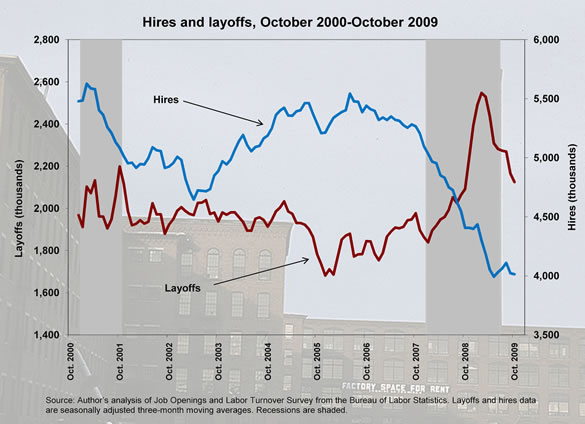By Heidi Shierholz
For the labor market to begin recovering from the dramatic losses of the last two years, two things must happen: Layoffs must decline, and hiring must pick up. The good news is that layoffs have slowed significantly. The red line in the figure shows layoffs over time.[1] Layoffs increased dramatically over the recession — at their peak in the first quarter of 2009, there were an average of 2.5 million layoffs each month, or around 119,000 layoffs each business day. In October 2009, the latest data available, there were 2.1 million layoffs, an enormous improvement. While layoffs are still high, they are far down from their peak and moving in the right direction.

The bad news is that hiring has not yet resumed. The blue line tracks the number of monthly hires since 2000. In December 2007, there were 5.1 million hires.[2] Since that time, hiring has dropped dramatically. In October 2009, there were 4.0 million hires, a 22% decline. Hiring does not appear to be dropping further — the number of hires in October was roughly the same as the number of hires in early summer. But unlike layoffs, hiring has not turned the corner.
Put together, these two lines tell the following story – fewer and fewer people are losing their jobs each month, but people who are out of work are not yet able to find jobs. Hiring remains far below what would be needed to put the 15.4 million unemployed workers in this country back to work. The Economic Policy Institute has detailed a five-point American Jobs Plan that would create or preserve at least 4.6 million jobs in the first year, and which could be paid for with a small sales tax on financial transactions that would recoup the entire cost of the plan within 10 years. It is time to act decisively to generate jobs and get the labor market on track to a robust recovery.
(Andrew Green provided research assistance)
[1] Even in good times, there are a large number of layoffs as the labor market churns – in December 2007, the most recent business cycle peak, there were 1.8 million layoffs.
[2] There are always many more hires than layoffs, so the fact that there are currently more hires than layoffs doesn’t imply total employment is growing. Importantly, layoffs represent only one form of “employment separation” – others include voluntary quits unrelated to retirement, retirements, transfers, job loss due to disability, and deaths. In October, there were 2.1 million layoffs but 4.2 million total separations, while there were 4.0 million hires.
